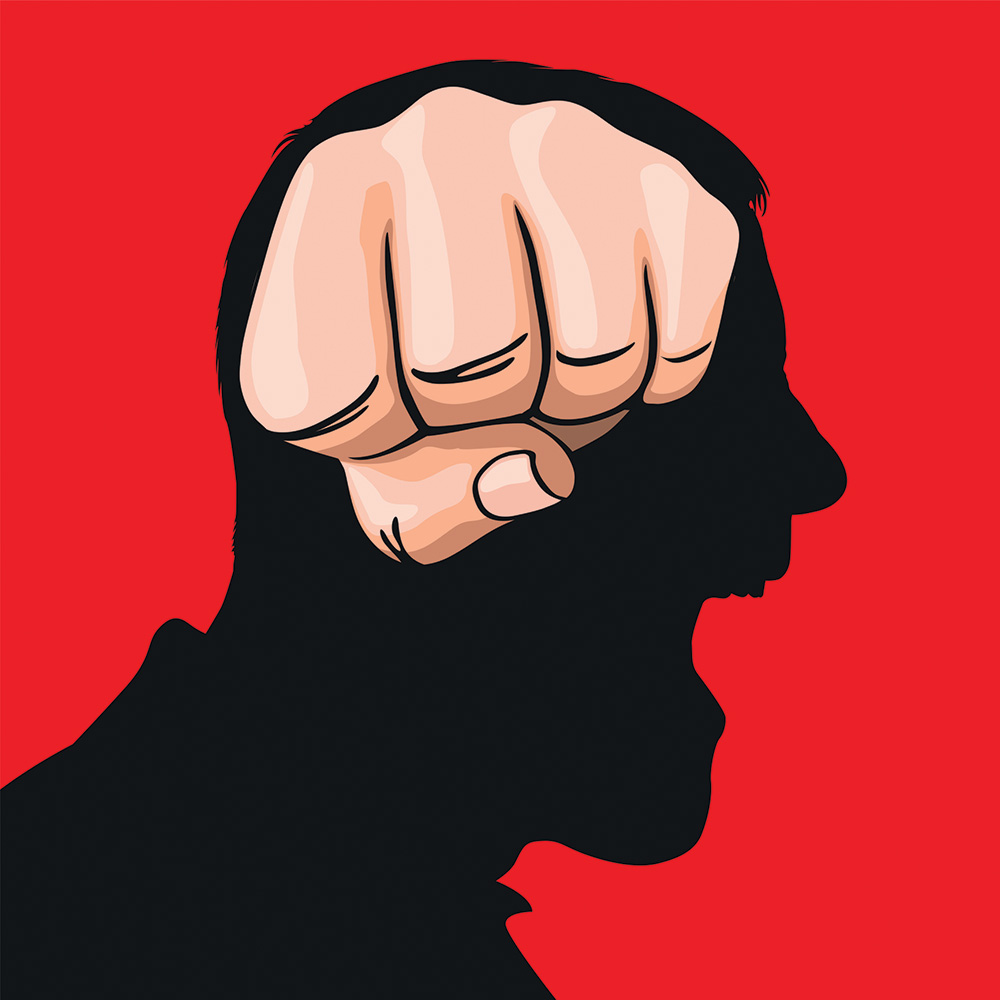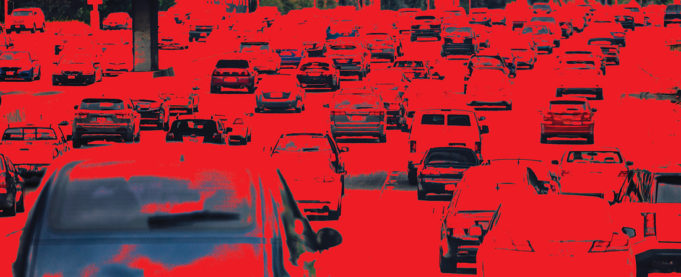Traffic was gridlocked on a busy stretch of I-30 in North Fort Worth, and a long line of cars and tractor-trailers glimmered in the hot sun. Rush hour traffic was stalled by a tangle of work crews, beeping construction trucks, and rows of traffic cones.
Someone was going to lose it — that was almost inevitable — as people tried to make their way home from work or wherever else they had been on a Friday afternoon.
The frustrating scene was familiar to Isel Valenzuela, who owns a home inspection company and spends much of his time driving to clients across the area. Dozens of times, he has seen drivers put themselves and others at risk with rude or reckless behavior, Valenzuela said in a phone interview.
On June 25, Valenzuela found himself caught in one of those violent dramas. Before the day was over, a young man would lose his life.
While caught in the traffic, Valenzuela heard a buzzing sound in the distance. A bright green motorcycle quickly came into view, weaving in and out of traffic and driving between lanes, he said.
The motorcycle pulled between cars ahead of him, and moments later, shots rang out, he said. The next thing he noticed was a man lying on the pavement with blood covering his chest and stomach.
Valenzuela grabbed an emergency first aid kit that he keeps in his car and rushed over to help the man, later identified as JaDerek Gray, 19.
“I need to breathe,” Valenzuela heard Gray say. “I’ve got to get up.”
As Gray tried to talk, Valenzuela heard a gurgling sound inside the teenager’s lungs, and “I knew it was bad. I told him help was coming. I tried to hold him down and put pressure on the wounds.”
Using trauma patches, Valenzuela tried to stop four profusely bleeding gunshot wounds. When emergency crews arrived a few minutes later, they also tried to stop the bleeding.
Gray was rushed to a nearby hospital, where he was pronounced dead.
On that day, Valenzuela tried to save the life of a young man, who — for reasons no one will ever know — stopped his motorcycle in the middle of traffic, lowered the kickstand, drew a gun, and walked toward an SUV that was also stuck in the traffic.
Inside the SUV was a man and his family. He also had a gun.
According to other witnesses, the man yelled for Gray to drop his weapon, but after he refused, the other man shot Gray multiple times. The driver was not charged because a police investigation determined that Gray was the aggressor and the SUV driver acted in self-defense.
“I wish I would have seen more,” Valenzuela said. “We only have one side of the story. We’ll never be able to ask him what his side was.”
After Gray’s death, his Facebook page was relentlessly trolled for weeks with comments saying that he got what he deserved.
Although Gray’s case has an unusual twist, its deadly ending is — unfortunately — not uncommon.
Dozens of reports, injuries, and deaths from road rage incidents have been reported in Fort Worth, the region, the state, and across the nation. In recent months, the problem has escalated.
“Road rage” is a term that describes dangerous or violent acts by drivers or passengers, but Texas has no specific criminal charge called “road rage.” That makes it difficult for police and the public to know the scope of the problem. There is also no way to gauge how many people encounter hostile drivers and never report it.
“In Fort Worth and across North Texas, we can see what seems to be an increase in reported cases, but statistically, no reported offenses are categorized under ‘road rage,’ ” said Brad Perez, a spokesperson for the Fort Worth police department.
Referring to an incident as road rage is “the afterthought regarding the actual crime that occurred,” Perez said.
*****
Whatever it’s called, violence on the roadways is a growing problem.
Texas’ new open carry law that went into effect Sep. 1 has safety advocates worried that road violence could continue to increase.
An average of 42 people per month have been shot, killed, or wounded in road rage incidents so far in 2021, according to the gun safety nonprofit Everytown Research & Policy. That amounts to one person being shot and either injured or killed in a road rage incident every 18 hours, on average.
Everytown says the number of road rage injuries and deaths nationwide have increased yearly since 2018.
“If current trends continue, 2021 is on track to be the deadliest year on record, with a projected 500 people injured or killed in road rage shootings,” Everytown says.
The National Rifle Association (NRA) pushed for the Texas open carry law that allows “law-abiding” citizens to carry a handgun without a permit. The NRA was also behind getting similar laws passed in 20 other states.
Although it doesn’t always end in a gun fight, there are warning signs from other drivers that violence is brewing.
Aggressive driving often leads to more serious problems, according to Triple A (American Automobile Association). Aggression is often triggered by traffic delays, a lack of patience, stress, or disregard for laws and basic courtesy, police and traffic safety advocates say.

Aggressive drivers are the ones you’ll see speeding, swerving in and out of lanes, and running red lights. Some of their other tactics are blocking cars from passing or changing lanes, unnecessarily blaring their horn, yelling, and making rude or obscene gestures.
In their most dangerous state, hostile drivers will brandish or fire a gun, sideswipe your car, ram into your car, or otherwise try to run you off the road, as illustrated in area police cases. Other times, victims are simply in the wrong lane at the wrong time. There seems to be no reason they were the target of someone else’s explosive anger.
In some cases, people are left traumatized, severely injured, or dead as their assailants speed out of sight. The fast pace and stress of the moment can make it nearly impossible for victims and witnesses to be able to describe the vehicle or driver, police said.
Tangling with a violent driver can have other consequences, as well. Vehicle insurance may not cover damages from so-called road rage incidents. Part of the problem is how some insurance policies define the difference between a criminal act and an “accident.”
“It really depends on all the circumstances of the event and the driver’s insurance policy,” said Ben Gonzalez, a spokesperson with the Texas Department of Insurance. “That policy is a contract between you and the insurance company, and while there are hundreds of different variations on the market in Texas, many policies have exclusions for ‘intentional acts.’ ”
*****
Road rage has caused serious injuries and deaths in North Texas, shown in a sampling of recent incidents. Although road rage often seems to happen after a random or brief altercation, at least one recent shooting on a Fort Worth highway happened after a woman was stalked and harassed.
Stanley Frank Szeliga, 54, of Irving, is facing a murder charge for allegedly shooting and killing Abigail Saldana, 22, of Wichita Falls, according to reports.
Police found the victim after responding to a call about a “major accident” on State Highway 183, said the police force’s Perez. She was treated by emergency crews but was pronounced dead at the scene.
“Detectives found evidence to indicate that the suspect had recently been stalking and harassing the victim and that the suspect had been following the victim just prior to the shooting of the victim in Fort Worth,” Perez said.
Days earlier, an Instagram video posted by Saldana showed what appeared to be a tracking device that she found attached to her car.
Szeliga was arrested after members of Fort Worth’s SWAT team served a search warrant at his apartment. After gaining entry, he was “located on a balcony of the residence and was found with several self-inflicted cut wounds on various parts of his body,” police said.
The wounds were mostly superficial, and after medical treatment, he was taken to the Fort Worth jail and bond was set at $250,000.
The investigation is ongoing, police said.
Hamzah Faraj, 24, a delivery driver, died after being shot in the head on Sep. 11 at Altamesa Boulevard and Kingswood Drive in Southwest Fort Worth.
Faraj was reportedly shot by someone driving a gray four-door Dodge pickup truck. After the shooting, he was taken to a nearby hospital and died several days later. Faraj’s wife, who was also in the car, was injured by gunfire but survived, according to published reports.
So far, Faraj’s killer remains at large as his family and police publicly plead for someone to come forward with information.
His mother, Athraa Hezam, told NBC 5 that she and her son moved to North Texas from Iraq in 2013 in hopes of finding a better life. Her son was recently married and was an aspiring music composer, according to the report.
Faraj is not the only person to fall victim to a violent driver.
On Aug. 14, two people were shot on eastbound Southwest Loop 820, WFAA reported. A fight from a nightclub is believed to have caused the freeway shooting, the report states.
Both victims in that incident sustained non-life-threatening injuries.
The list continues with a July 17 incident involving a man who shot at a woman as she was driving home from a bar.
In an email response, Fort Worth police said they were called at 12:43 a.m. to 3301 Matlock Road in Arlington for a shooting that initially happened in Fort Worth. The victim told officers she was driving on I-30 near Beach Street in the central area of Fort Worth when a male driver began shooting at her. She tried to follow the suspect and obtain his license plate before she crashed her car off Cooper Street in Arlington city limits, police said.
The victim, who was not identified, was taken to an Arlington hospital where she received treatment for non-life-threatening gunshot wounds to the arm and abdomen, police said.
The suspect’s vehicle was found abandoned at 8700 N. Normandale St., and he remains at large.
On Aug. 3, a person was shot and hospitalized with non-life-threatening injuries after tempers flared in a parking lot of an apartment complex in Fort Worth, according to published reports. The shooting happened at 3008 W. Normandale St. at 11:20 a.m. behind a Harley Davidson dealership. That offender also has not been found.
Following a road rage incident in June, Fort Worth police arrested Daniel Melendez, 38, on a manslaughter charge relating to the death of Najdeh Pariai, 63, of Euless. According to reports, Pariai was punched once after getting out of his vehicle to argue with Melendez. The blow knocked Pariai to the pavement, and he hit his head. Pariai later died.
On March 18, Carrollton police reported an arrest in what the department called the worst case of road rage it has ever seen.
In a news release, Carrollton police said Dillon Stoffregen, 26, was charged with three counts of aggravated assault with a deadly weapon for allegedly stabbing two people and strangling a third.
After an accident that Stroffreggen reportedly caused, he emerged from his car and assaulted two other drivers who were involved as well as a passerby who tried to intervene in the brawl.
Stoffreggen and the three others who were injured were all treated for non-life-threatening injuries at area hospitals.
*****
Although hostile drivers are rampaging across Texas roadways, the way incidents are reported leaves us with an inaccurate picture of the extent of the problem.
The Texas Department of Transportation documented 1,383 crashes statewide that involved road rage in 2020. Nine of them were fatal.
In Fort Worth, “there is not an official tally or way to categorize reported offenses under the title of road rage,” the police force’s Perez said. “Any criminal offense that occurs during a vehicular incident is titled under that criminal offense.”
The department also gathers no data on what areas of the city are more prone to aggressive drivers, he said.
If a crime occurred, it will be assigned to the department’s specific unit, Perez said. If a death occurred, the case will be assigned to homicide detectives, he said.
Depending on what an investigation uncovers, an offender could be charged with reckless driving, assault by contact, assault by threat, deadly conduct, or vehicular assault, for example.
“All violent actions are unfortunate and should not occur,” Perez said, “especially when someone loses their life or innocent and uninvolved persons become victims.”
Fort Worth Police said in an Oct. 29 Twitter post that the department’s traffic division is increasing its enforcement of moving violations, which include speeding and the so-called “move over” law that requires drivers to use caution when approaching emergency crews or utility workers.
Other cities have also found it challenging to control road rage, given the nature of how it happens.
“Road rage incidents can be difficult to investigate,” said Tim Ciesco, a spokesperson for the Arlington police department. “For starters, it can sometimes be challenging to determine where specifically an incident took place, which creates extra hurdles for our investigators, who want to collect physical evidence and locate witnesses who saw the offense.”
Beyond that, victims often do not know the identity of the suspect, Ciesco said. While in fast-moving traffic or in the middle of a life-threatening situation, victims rarely can snap a photo of a suspect’s vehicle or write down a license plate number, Ciesco said.
In 2020, Arlington police responded to 19 road rage incidents that generated police reports, Ciesco said. As of July 2021, the department had responded to 13 incidents that have generated police reports.
Arlington police established a hotline (817-459-5389) that allows drivers to report road rage. Since 2017, the hotline has received 1,253 calls and the police department’s traffic unit has sent out 737 letters to the registered owners of vehicles that were reported.
Every day, Arlington police receive at least one or two reports of people driving aggressively, the department says.
Road rage became such a problem in Dallas over the summer that police announced they were stepping up patrols to attempt to stop out-of-control drivers. Over one two-week period in June, Dallas documented six road rage incidents.
“It’s definitely something we are concerned about, but again, the randomness of it is alarming, and we are struggling with it,” Dallas Police Chief Eddie Garcia told WFAA.
In one of the Dallas cases, Jason Soto, 18, was shot in the head and killed during an argument with another driver at an intersection of the 2300 block of South Hampton Road, according to published reports.
Soto crashed his car after being shot and died en route to a nearby hospital, reports state. Tomas Rodriguez Jr., 27, was charged with murder in connection with the shooting.
Dallas police are still looking for the person who shot and killed Christopher Murzin, 53, as he was driving on I-20 in February. In June, Murzin’s family boosted its reward to $50,000 for anyone who has information that leads to an arrest.
Elsewhere in the state, road rage cases have plagued Houston. From January through April this year, law enforcement agencies reported at least 107 road rage crashes in Harris County, KPRC 2 in Houston reported.
In July, a driver shot and killed a teenager who was leaving an Astros game with his father. His father exchanged hand gestures with the other driver, who followed the family and shot at them several times.
The family is offering a $10,000 reward to find Castro’s killer. So far, the case remains unsolved.
On Oct. 10, the Harris County Sheriff’s Office investigated a road rage incident on the freeway service road near Aldine Mail Route in northeast Harris County, KHOU in Houston reported.
A man who was cut off in traffic stopped his car, grabbed a crowbar, and stormed toward the other driver. The other driver fired a shot at him. Unfazed by the gunfire, the man began pummeling the other driver’s truck with the crowbar. More shots were fired and grazed the man with the crowbar across the forehead and hand.
The man with the crowbar was so crazed, according to the report, that the gunman sped off and called 911 because he feared for his life. No one was seriously injured in the attack, and no charges were filed.
But Texas is not the only state hit being with a barrage of road rage headlines. Reports of road rage flood the news every day across the nation.
In Oklahoma, a video captured in August on I-35 in Edmond shows a man in a red truck aggressively veering in and out of traffic and cutting off other drivers. Steven Coughran, 40, was charged with felony assault and battery with a dangerous weapon and child neglect after he allegedly rammed another driver into a concrete median while going 80 mph. Coughran’s 4-year-old child was onboard during the violent exchange. Coughran blamed his actions on a naturally produced chemical.
“Not going to lie, I was being a dumbass,” Coughran reportedly told a trooper on the scene. “You know how testosterone is.”
*****
Road rage is one factor that’s making driving unsafe in states across the country. Despite fewer people being on the road during the pandemic, a report by the U.S. Department of Transportation’s National Highway Traffic Safety Administration showed an increase in crash fatalities in 2020. Speeding was the main factor.
Although Americans drove less in 2020 due to the pandemic, early estimates by the federal agency show that an estimated 38,680 people died in crashes. That represents the largest projected number of fatalities since 2007.
All of this raises questions about what drivers can do to protect themselves and what is being done to rein in aggressive and sometimes deadly drivers. Because road rage can happen anywhere and at any time, the best defense we have is to avoid becoming a victim.
Being a defensive driver and never engaging with an angry driver are just two ways to protect yourself, Ciesco said. Your best bet is to remove yourself from the situation as quickly and safely as possible, he said.
Police and safety advocates also recommend never making eye contact with other drivers.
If you believe your life or someone else’s life is in danger due to how someone is driving, your best bet is to call 911 as soon as it is possible to do so, Ciesco said.
*****
Drive down any busy highway in North Texas, and you’re likely to encounter or witness aggressive drivers. Too many people seem obsessed with being first, getting ahead of everyone, or refusing to let people change lanes or merge into traffic. If it seems like there are more angry people on the road, it’s probably not your imagination.
Frustration from the pandemic, overcrowded highways, and stress from life in general are causing some people to drive more dangerously.
Since early 2020, the pandemic has forced us to live and work in circumstances we’ve never experienced before, and that has caused severe stress for many people, said Leigh Richardson, a counselor and the clinical director of the Brain Performance Center in Dallas.
By July 2020, the pandemic began causing an uptick in mental health issues, according to Yale Medicine.
In addition to job losses caused by business closures, working from home, health concerns, and isolation, families had to contend with organizing online school classes or home-schooling for their children. By fall, more uncertainty and upheaval raised questions about whether kids should or shouldn’t return to their classroom campuses.
Aside from all of that, people were hit with daily news reports that counted COVID-related hospitalizations and deaths.
In recent weeks, Fort Worth and Texas saw bitter debates over whether schools should enforce the wearing of protective face coverings to slow the spread of the virus.
Amid periods of prolonged, excessive stress, one minor setback or inconvenience can cause some people to explode, Richardson said.
Some people already have a predisposition to lose their cool. How a person’s brain is “wired” can make them more inclined to be explosive or impulsive, Richardson said. During the pandemic, people have become more isolated and insular, she added. Some people have completely shut down.
“They have truly enjoyed not being around people,” she said.
Now everyone is having to interact again, especially as companies bring more people back into working on-site. That has also led to more traffic on roadways.
The cumulative effects of stress can also have an impact. As stress piles up, one more disappointment or setback can be overwhelming, she said. “Maybe we get an email from our boss that made us mad, or maybe we’re going someplace and we’re not sure where we’re going. Someone honks a horn or gives finger language, and we’ve lost it.”
Even more so during the pandemic, people seem to have lost the basic courtesy and people skills required for social interactions. And that has also spilled onto our roadways.
“We forgot how to play nice, and the frustration level is so much higher than it has ever been before,” Richardson said. “We’ve lost our empathy.”












